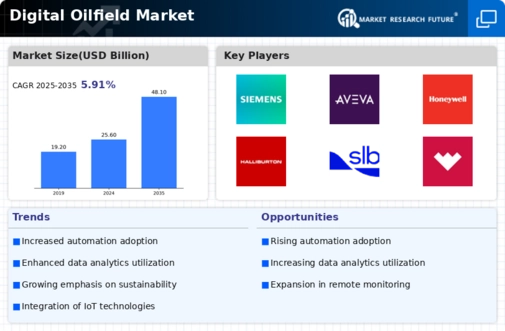Advancements in Data Analytics
The Digital Oilfield Market is witnessing rapid advancements in data analytics, which are transforming how companies operate. Enhanced data analytics capabilities allow for more accurate forecasting, risk assessment, and performance optimization. The market for data analytics in the oil and gas sector is projected to grow significantly, with estimates suggesting a compound annual growth rate of over 25% in the coming years. This growth is attributed to the increasing volume of data generated from various sources, including sensors and drilling equipment. By harnessing this data, companies can make informed decisions that improve operational efficiency and reduce downtime. Consequently, advancements in data analytics are likely to play a crucial role in shaping the future of the Digital Oilfield Market.
Growing Focus on Sustainability
Sustainability has emerged as a pivotal concern within the Digital Oilfield Market, as stakeholders increasingly prioritize environmentally friendly practices. The oil and gas sector is under pressure to reduce its carbon footprint, and digital technologies offer solutions to achieve this goal. For instance, the integration of digital tools can facilitate better resource management and minimize waste. Reports suggest that companies leveraging digital solutions can potentially reduce greenhouse gas emissions by 30%. This growing emphasis on sustainability not only aligns with regulatory requirements but also meets the expectations of consumers and investors who are increasingly favoring sustainable practices. Thus, sustainability is likely to be a significant driver in the Digital Oilfield Market.
Integration of Automation Technologies
Automation technologies are becoming increasingly integral to the Digital Oilfield Market, as they enhance operational efficiency and safety. The adoption of automation solutions, such as robotic process automation and autonomous drilling systems, is on the rise. These technologies not only streamline operations but also reduce the risk of human error, which can lead to costly accidents. Industry reports indicate that the automation market in oil and gas is expected to reach several billion dollars by the end of the decade. This trend suggests that companies are recognizing the value of automation in improving productivity and ensuring compliance with safety regulations. Therefore, the integration of automation technologies is likely to be a key driver in the Digital Oilfield Market.
Increased Demand for Operational Efficiency
The Digital Oilfield Market is experiencing a surge in demand for operational efficiency as companies seek to optimize their production processes. This drive is largely fueled by the need to reduce operational costs while maximizing output. According to recent estimates, the implementation of digital technologies can lead to a reduction in operational costs by up to 20%. Companies are increasingly adopting advanced technologies such as IoT and AI to monitor and analyze data in real-time, which enhances decision-making processes. This trend indicates a shift towards more data-driven operations, where efficiency is paramount. As the industry evolves, the focus on operational efficiency is likely to remain a key driver in the Digital Oilfield Market.
Rising Investment in Digital Transformation
Investment in digital transformation is a prominent driver within the Digital Oilfield Market, as companies seek to modernize their operations. The shift towards digitalization is being propelled by the need to remain competitive in a rapidly evolving market. Recent data indicates that investments in digital technologies within the oil and gas sector are projected to exceed billions of dollars in the next few years. This influx of capital is directed towards upgrading existing infrastructure and implementing new digital solutions that enhance efficiency and productivity. As companies continue to prioritize digital transformation, it is likely to remain a significant driver in the Digital Oilfield Market, shaping the future landscape of the sector.


















Leave a Comment